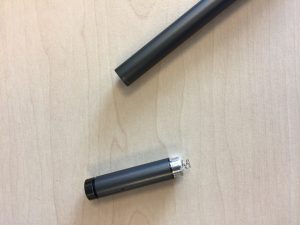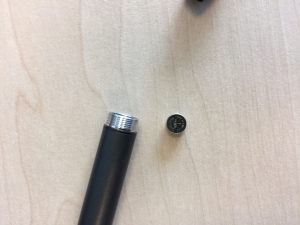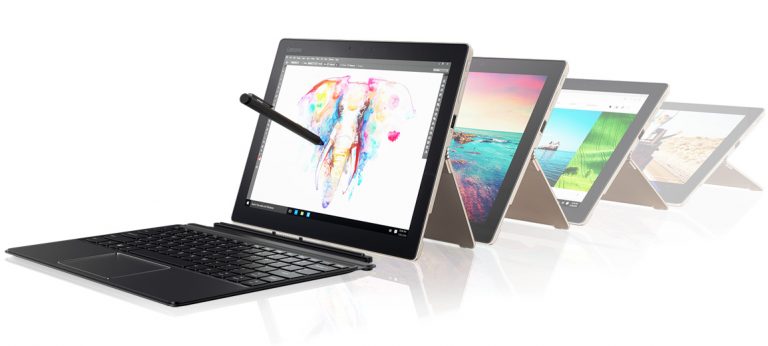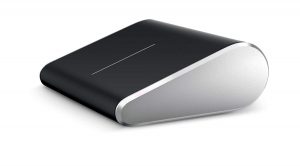The Lenovo Miix 720 is Lenovo’s latest attempt at creating a business class hybrid device in the mould of the Microsoft Surface Pro 4. Lenovo gets a lot of things right with this version, however there are some nagging issues which you may need to consider before rolling these out in your business, or even buying one for home.
This review is written primarily from the perspective of a business implementation, since that is the target audience for these machines, however many points would equally apply to the home user.
Specs
The units we tested came with a Core i5-7200U CPU, 8GB of RAM, and a 256GB NVMe SSD. Al units come with a 12.0″QHD+ 2880×1920 screen with Gorilla Glass, which is perfectly adequate. The CPU is a dual core Kaby Lake chip, and combined with the RAM and speedy SSD, performance was generally excellent. We suspect this configuration may the sweet spot for many organisations, offering a good balance of cost and performance.
The spec tops out at an i7-7500U with 16GB of RAM, however from the service manual it appears that the RAM is not upgradable, i.e. it is soldered to the motherboard.
For those into numbers, the SSD is a Samsung MZVLV256, unfortunately CyrstalDiskMark did not detect the disk so we were unable to test the performance.
Screen
The unit itself is very similar to the Surface Pro 4 in terms of size and weight. However the screen is slightly smaller (12″ vs 12.3″ on the SP4) due to a wider bezel, which is a little disappointing. The screen is also a fingerprint magnet, and even after using a screen wipe it still had smudges all over it, so much so that someone walking past commented on it even after I had just cleaned it. This is only really apparent when the screen is off however, using in docked mode. It should be noted that any laptop with a very high DPI display will have issues if you want to use the built in display with an external monitor that is not also very high res, you will encounter issues with display scaling. The problem is that different displays will require different scaling settings to appear a comfortable size, however Windows (or to be precise, some applications) do not handle this well. This can result in strange effects, such as:
– Connecting the device to e.g. an HD screen after booting it up when not docked, will result in blurry text in many applications, including Office.
– If you booted up when docked, and then undock the device, some applications will appear tiny. For example the IE11 will be so small as to be unusable. Chrome or Edge are fine.
The solution is to log off and on again whenever docking or undocking, and also using only the external display when docked, otherwise you will have mixed scaling settings and one of the screens will look blurry in some applications.
Kickstand
The kickstand uses Lenovo’s intricate watch band hinge similar to the Yoga 900 and 910, however it only has a hinge present on each side unlike those other models. It works well enough, however it is quite easy to push the device down and the hinge slides backwards. In fact on a smooth table it can slide down to near horizontal when slightly dropped on the table, or when prodded. So it doesn’t provide as much resistance as you might like, certainly less than the SP4 which is more solid.
Reparability
The great thing about Lenovo machines it that the Hardware Maintenance Manuals (HMM) are freely available. The HMM for the Miix 720 (https://download.lenovo.com/consumer/mobiles_pub/miix720-12ikb_hmm_201611.pdf) lists all of the parts which are replaceable, and how to disassemble the device. That Lenovo can achieve this level of reparability in the device the same form factor as the Surface Pro 4 is quite an achievement, and refreshing change from machines that are getting to be neigh on impossible to attempt to upgrade or repair yourself (or indeed, at all – I am looking at you Surface Laptop!).
Ports
The Lenovo has a good selection of ports, with 2 x USB A and 1 USB Type-C. The included power supply provides power over USB-C, which makes for a neat docking solution if using something like the Lenovo USB-C dock, since only a single able is needed for power, video, data and network. However because there is only one USB-C port, this does present a small problem at home or on the move, since if you want to use a USB-C dongle (e.g. to connect HDMI when working from home) then you cannot charge the device at the same time. The Lenovo USB-C travel hub
Keyboard
The keyboard is as good as can be expected from a unit like this. The typing experience is fine, however the right shift key is tiny, a single key wide as opposed to about 2.5 keys wide on most keyboards. This makes touch typing very annoying if you are used to using the right shift key with your little finger, you will hit the wrong key every time and end up doing cursor up instead of shift. This is incredibly irritating and I don’t know why Lenovo decided to change the standard keyboard layout. There are many users commenting on this design in the forum https://forums.lenovo.com/t5/Lenovo-Yoga-Series-Notebooks/Lenovo-Yoga-710-how-to-remap-reassign-Right-Shift-and-PgUp-keys/td-p/3353608 however it is possible to use Keytweak to change the up arrow to function as shift instead.
The keyboard is also backlit with two levels of brightness, and enabled via the usual FN + Space combination, this is nice in a low light environment.
The other benefit of a device like this, is that if a user spills a drink on the keyboard, instead of writing off the whole machine, you simply swap out the keyboard. So this should balance the potential number of increased breakages due to fragility in other areas compared to a normal clamshell laptop.
Stylus
3 Styli (from bottom to top): Surface Pro 4, Lenovo Active Pen, Lenovo Active Pen 2
The Lenovo 720 comes with the newer Lenovo Active Pen 2, at least in most countries. Some people are reporting on the forum that they have received them with the Active Pen 1, which has no button on the top or Bluetooth functionality, so you should check with your Lenovo rep depending on which country you are in.
Otherwise the Active Pen 2 feels like a nice upgrade from the previous model. In addition to the single AAAA battery that the previous model took, this stylus unscrews in the middle and 2 more tiny watch batteries (319 SR527SW) go in the other end. Somewhat fiddly to replace but they should last a good amount of time. These power the Bluetooth functionality and the button on the top, in fact the button still works even if the pen is in half.
Button batteries for Bluetooth and the top button.
The new stylus is longer than the previous generation, and the additional button at the top is very useful as a PowerPoint remote, functionality it supports out of the box, and it can also be configured to open any app you like. OneNote is the obvious candidate as that is often used for taking hand written notes. The 2 buttons on the bottom are also larger and easier to use, by default the top one is for right click, the bottom one for erase, although this is also configurable. There is a Wacom Pen application for some of the more advanced settings which are not present in the default Windows 10 control panel settings. It is also worth noting that both of these work find in the LTSB version of Windows 10 Enterprise.
The new stylus also supports Wacom’s new Active ES standard, with Windows Ink support and supports up to 4,096 pressure levels compared to 1024 on the Surface Pro 4, so this should be a good tablet for drawing. It does not however support tilt
It is completely spherical as you can see from the photos. This means it rolls exceptionally well, which means it is more likely to get lost by rolling off a table or desk. This issue is largely caused by the fact that Lenovo dropped the pen clip from the pen, in fact if you look at the product pages e.g. at http://www3.lenovo.com/gb/en/laptops/ideapad/miix-series/Lenovo-MIIX-720-12IKB/p/88IPMX70799 you can clearly see the clip on the pen, as per the image below. Some users even reported buying a pen with the clip, however our Lenovo rep said that it was dropped due to quality control issues. There is no pen loop, just an awful plastic dongle which goes into a USB port (and feels like it will break it). This sticks out so much you would not want to put it into a bag with it attached. So with no clip, and no decent pen storage, these things are going to get lost like nobody’s business.
Where’s the pen clip?
Performance
Performance is generally very good. Running the Excel benchmark from http://exceltrader.net/984/benchmark_et-xls-an-excel-benchmark-for-traders/, the 720 performed better than the previous generation Surface Pro 4 and Miix 510, which you would expect from the new Intel chips. Whilst the fan spins up under load, performance was generally good across the board. Below are the test results from a few devices which we had to hand.
| Model | Fujitsu P702 (i3 2nd gen) | Lenovo X240 (i5 4th gen) | Microsoft Surface Pro 4 (i5 6th gen) | Lenovo Miix 510 (i5 6th gen) | Lenovo Miix 720 (i5 7th gen) |
|---|---|---|---|---|---|
| CPU | i3-2370M | i5-4300U | i5-6300U | i5-6200U | i5-7200U |
| RAM | 4GB | 8GB | 8GB | 8GB | 8GB |
| Average | 17.25 | 49.76 | 71.15 | 72.99 | 77.27 |
Pros
– USB-C port, plus 2 normal USB 3.0 Type-A
– Light, yet sturdy
– Improved pen
Cons
– Noisy fan, hot
– That pen will get lost. A lot.
– Keyboard has a tiny shift key making typing annoying
Overall
What Lenovo have managed to create is a hybrid laptop/tablet, almost identical to the Surface Pro 4, however with more up to date connectivity with USB-C, mil-spec tested, and serviceable parts. That is certainly an engineering achievement. However there are comprises with a smaller screen, poor cooling, noisy fan, and a stylus with a mysterious missing clip. Performance is good however, and all in this would make a decent choice for enabling more flexible working within a business, and it is recommended as long as you don’t mind having a large stock of spare pens. Hopefully in the next iteration Lenovo can iron out some of the issues with this generation, they are certainly close to a perfect business hybrid but not quite there yet. I hope that the next version will have a slightly larger screen with less bezel, a better pen with storage, will be silent, and have sorted out the shift key size. Then I’m sold.






